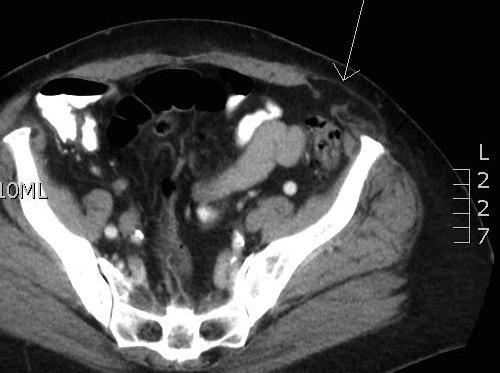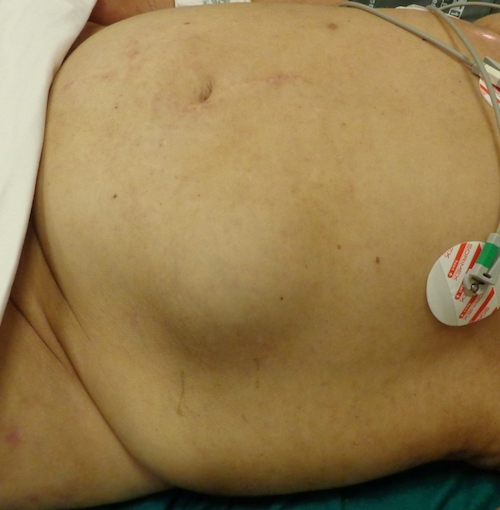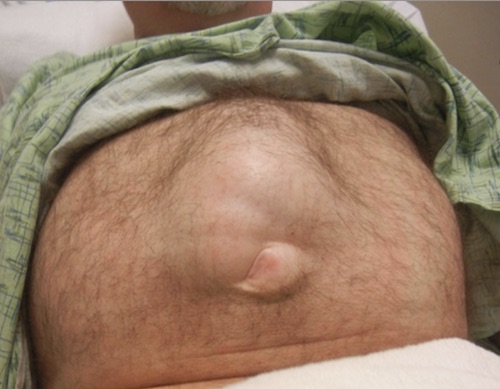Abdominal Wall: Ventral Hernias
Typical Ventral Hernias
Ventral Hernia Definition
- Definition: Hernia of the Anterior Abdominal Wall
Types
- Incisional Hernia
- Hernia Through a Prior Incision
- Port-Site Hernia – Incisional Hernia Through a Prior Port Site
- Develop in 10-15% of Incisions
- Only a 0.0-0.5% Risk in Pfannenstiel Incisions
- Risk Factors:
- Surgical Site Infection (Highest)
- Obesity
- Diabetes
- Increased Intraabdominal Pressure (COPD, Cystic Fibrosis, etc.)
- Malnutrition
- Immunosuppression
- Midline Incisions (Less Common with Transverse or Oblique Incisions)
- Vertical Incisions
- Use of Bladed Trocars
- Efforts to Avoid Port-Site Hernias:
- Close All Ports ≥ 10 mm
- Consider Closing 5 mm Under Excessive Traction or in Children
- Include All Layers in Closure
- Use the Fewest Ports Possible with the Smallest Diameter
- Close All Ports ≥ 10 mm
- Umbilical Hernia
- Hernia Through the Umbilical Ring
- 3x More Common in Women
- 90% of Women Develop an Umbilical Hernia During Pregnancy
- Strangulation More Common in Men
- Proboscoid (Elephant-Trunk) Hernia
- Definition: Large Umbilical Hernia with Excessive Stretching of the Skin Resembling a Trunk
- Named After the Nose of a Proboscis Monkey
- Usually At Least a Few cm in Diameter
- Epigastric Hernia
- Hernia Between the Umbilicus & Xiphoid Along the Linea Alba
- Usually Small Containing Preperitoneal Fat
- More Common Above the Umbilicus Than Below
- Obliterated Umbilical Vessels & Urachus Reinforce Abdominal Wall Below
Diagnosis
- Generally a Clinical Diagnosis
- US is the Preferred Imaging Modality If Uncertain
- Can Also Evaluate for Multiple Defects if Diagnosis is Uncertain
- More Cost Effective than CT & Allows Dynamic Assessment with/without Valsalva
- Consider CT for Evaluation of Large/Complex Defects
Treatment
- Small & ASx: Observe
- Large or Sx: Repair
- Mesh Indications: ≥ 1-2 cm
- *In General, if a Mesh Can Fit Through It Should be Used
- Component Separation
- Indications:
- Multiple Defects Unable to Close with Mesh
- Large Defect Unable to Close Primarily
- Large Recurrence that Failed Suture Closure
- Giant Omphalocele
- Relative Contraindications:
- Extensive Destruction of Abdominal Wall Components
- Compromise of Epigastric Arterial Supply (DIEP Flap, etc.)
- Active Infection
- Indications:
- Emergent or Contaminated (Necrotic Bowel) Options:
- Suture Repair
- Mesh Repair – May Consider Absorbable Mesh but Never Use Nonabsorbable Mesh in Contaminated Cases
- Staged Repair
- Close Skin with Planned Ventral Hernia & Delayed Definitive Repair
- Some Consider the Best Chance for a Good Repair
Open vs Minimally Invasive Comparison
- Open Surgery:
- Preferred for Large Defects (> 10 cm)
- Preferred for Loss of Abdominal Domain
- Preferred if Bowel is Compromised with Necessary Resection
- Incarceration Alone Can Be Done Laparoscopically
- Minimally Invasive:
- Decreased Risk of Wound Complications – Particularly in Obese
- Includes Hematoma, Seroma & Surgical Site Infection
- Shorter Length of Stay
- Comparable Operative Time
- Provides Better Visualization of Multiple Defects (Avoids Larger-Than-Needed Incisions)
- Decreased Risk of Wound Complications – Particularly in Obese
- Equivalent Recurrence Rates

Umbilical Hernia 1

Proboscoid Hernia 2
Spigelian (“Semilunar”) Hernia
Basics
- Definition: Hernia Along the Spigelian Line (Aponeurotic Band at Lateral Border of the Rectus Abdominis)
- Most are Interparietal – Herniates Between External & Internal Obliques (Can Be Confused with Rectus Sheath Hematoma)
- Tend to Have Small/Narrow Neck (1-2 cm)
- High Risk of Incarceration/Strangulation
Location
- Most Common at the Junction of the Spigelian Line & the Arcuate Line
- “Spigelian Hernia Belt” – Area Between the Horizontal Lines from Umbilicus to the ASIS (About 6 Inches)
- Due to Variable Position of the Arcuate Line
- Contains 90% of Spigelian Hernias
Diagnosis
- Dx: CT (Often Difficult to Palpate)
Treatment
- Tx: Repair All

Spigelian Hernia on CT 3

Spigelian Hernia 4
Other Ventral Hernias
Arcuate Line Hernia
- Hernia Under the Arcuate Line
- Preperitoneal Fold Ascending Upward Between the Posterior Aponeurotic Sheath & Rectus Abdominis Muscle
- Can Be Unilateral or Bilateral
- Defined as an Internal Hernia – No Defect Through the Abdominal Wall
- Majority are ASx with a Wide Hernia Orifice
- Often Misdiagnosed as a Spigelian Hernia
Posterior Rectus Sheath Hernia
- Hernia Through the Posterior Rectus Sheath
- Forms a Mass Within the Rectus Muscle
- Many are Interparietal
Diastasis Recti
- Definition: Separation of Rectus Abdominis Pillars
- Fascia Intact (Not a True Hernia)
- Most Common Postpartum or After Weight Loss
- Presentation:
- Many are Asymptomatic
- Can Cause Abdominal Pain
- Prominent Ridge Extending from the Xiphoid to Umbilicus
- Midline Fusiform Bulge Rises from Increased Intraabdominal Pressure (Sit-Up)
- Diagnosis: Clinical Examination
- US (Preferred) or CT Can Be Used if Diagnosis Uncertain
- Tx: Wall Strengthening & Weight Loss
- If Large/Significant Sx: Surgical Rectus Sheath Plication
- Add Abdominoplasty if Excess Skin
- Can Improve Pulmonary & Abdominal Wall Function
- If Large/Significant Sx: Surgical Rectus Sheath Plication

Diastasis Recti 5
References
- Wikimedia Commons (License: CC 1-1.0)
- Ashu EE, Leroy GM, Aristide BG, Joss BM, Bonaventure J, Patrick SE, Myriam FG. Double half-cone flap umbilicoplasty for proboscoid umbilical hernia in a 2 years old child with satisfactory results 2 years later. Pan Afr Med J. 2015 Sep 17;22:44. (License: CC BY-2.0)
- Wikimedia Commons (License: Public Domain)
- Wikimedia Commons (License: CC BY-SA-3.0)
- Cheesborough JE, Dumanian GA. Simultaneous prosthetic mesh abdominal wall reconstruction with abdominoplasty for ventral hernia and severe rectus diastasis repairs. Plast Reconstr Surg. 2015 Jan;135(1):268-276. (License: CC BY-NC-ND-3.0)